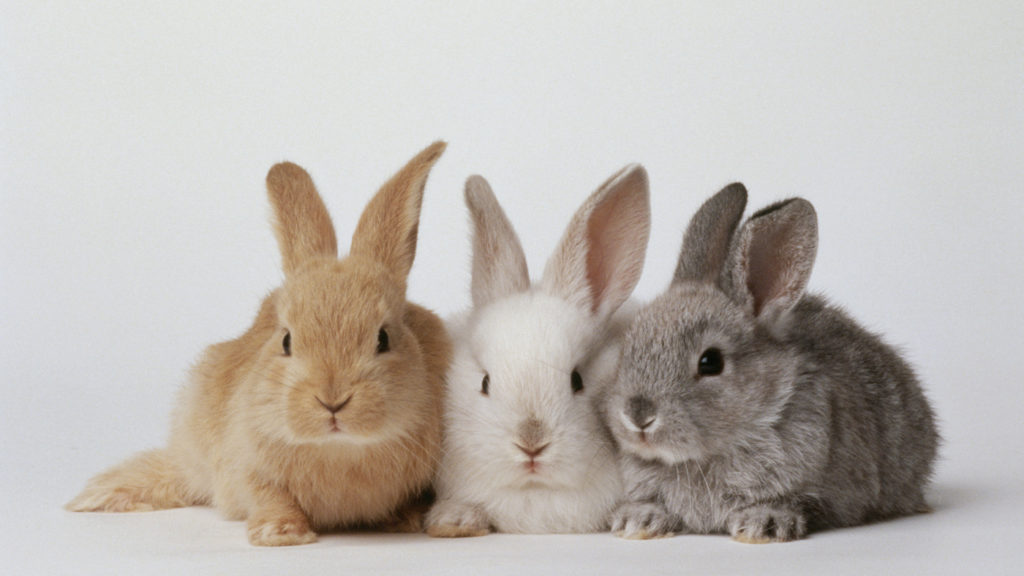Rabbit books and rabbit resources seem to proliferate like…well, rabbits. Famous rabbits include the fussy and opinionated Rabbit of A.A. Milne’s Winnie-the-Pooh, the pocket-watch-toting White Rabbit of Lewis Carroll’s Alice in Wonderland, Bambi’s friend Thumper, and Harvey, the giant invisible pooka rabbit in the 1950 James Stewart movie of the same name. And there are many many more.
According to a Chinese legend, there’s even a rabbit in the Moon.
Table of Contents
Imaginary Rabbits
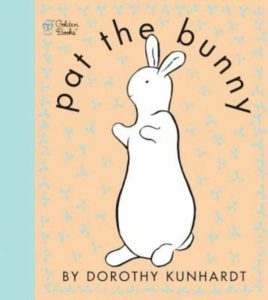
|
First book for a lot of babies is a bunny book. Dorothy Kunhardt’s furry and pattable Pat the Bunny (Golden Books, 2001), originally published in 1940, is now the best-selling interactive book of all time. (“Judy can pat the bunny. Can YOU pat the bunny?”) It makes for a great baby present, featuring six other appealing activities along with bunny-patting. |
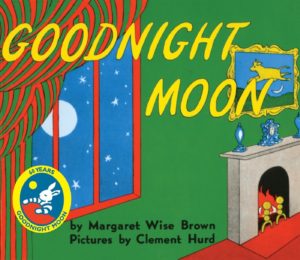
|
Margaret Wise Brown’s Goodnight Moon (HarperCollins, 2005), first published in 1947, is the enchanting now-classic bedtime story of the sleepy little bunny in the great green room (with a telephone, a red balloon, and a picture of a cow jumping over the moon). For ages 2-6. |
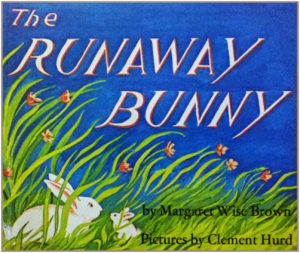
|
Also by Brown, see The Runaway Bunny (HarperCollins, 2005), an imaginative tale of running away, with a comforting background of maternal reassurance. The little bunny comes up with any number of run-away scenarios – he’ll become a fish, a rock on a mountain, a flower, a bird. His mother counters that she will always come and find him: she’ll be a fisherman, a mountain climber, a gardener, or the sheltering tree that he flies home to. For ages 2-6. |
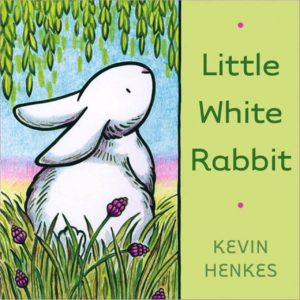
|
The protagonist of Kevin Henkes’s Little White Rabbit (Greenwillow, 2011) bounds off on a bright spring day, adventurously imagining himself green as the grass, tall as a tree, or flying with the butterflies. Then he encounters a cat – and is happy to scamper home to his mother. For ages 2-5. |
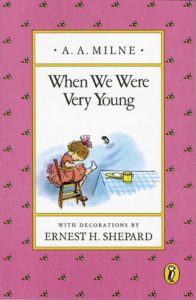 |
A.A. Milne’s “Market Square” is a wonderful poem about rabbits: “…I wanted a rabbit/A little brown rabbit/And I looked for a rabbit/’Most everywhere.” The poem originally appeared in Milne’s When We Were Very Young (Puffin, 1992). |
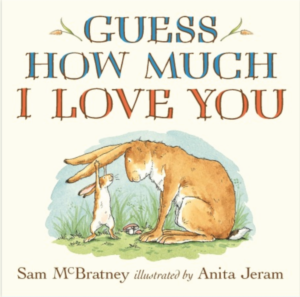
|
In Sam McBratney’s Guess How Much I Love You? (Candlewick, 2008), Little Nutbrown Hare and his much larger parent vie to see who loves the other best. (“I love you as high as I can hop.” “I love you right up to the moon.”) A charmer for ages 2-6. |
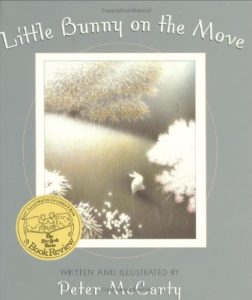 |
Peter McCarty’s Little Bunny on the Move (Owlet Paperbacks, 2003), illustrated with luminous pencil-and-watercolor drawings, is the story of a long journey home for ages 3-6. |
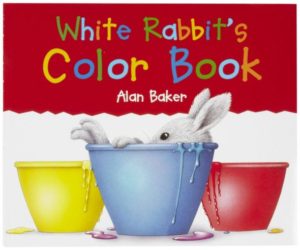
|
White Rabbit’s Color Book by Alan Baker (Kingfisher, 1999) won’t tell you much about rabbits, but it’s a charmingly illustrated picture-book account of colors and color mixing for ages 2-5. Similar in concept is Ellen Stoll Walsh’s Mouse Paint (Sandpiper, 1995). |
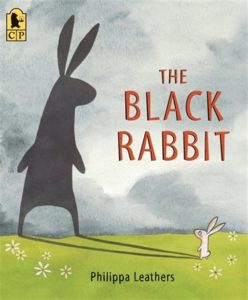
|
In Philippa Leathers’s The Black Rabbit (Candlewick, 2013), a little white rabbit is pursued wherever he goes by a looming black rabbit. (Readers can see that it’s his shadow.) He does everything he can think of to get rid of it, but nothing works – until finally he plunges into a shady forest. Where he runs into a wolf. For ages 3-7. |
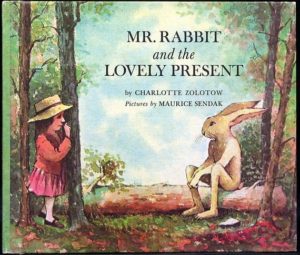
|
In Charlotte Zolotow’s Mr. Rabbit and the Lovely Present (HarperCollins, 1977), illustrated by the incomparable Maurice Sendak, a little girl enlists Mr. Rabbit’s help to find the perfect birthday gift for her mother, who loves colors. Red underwear, yellow taxicabs, green caterpillars, and blue lakes all seem like bad ideas – but Mr. Rabbit manages to find a perfect solution. For ages 4-8. |
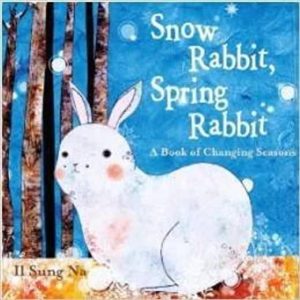
|
Rabbits turn white in winter – but what do other animals do? Il Sung Na’s charmingly illustrated Snow Rabbit, Spring Rabbit (Knopf Books for Young Readers, 2011) describes animal adaptions to the changing seasons for ages 3-6. |
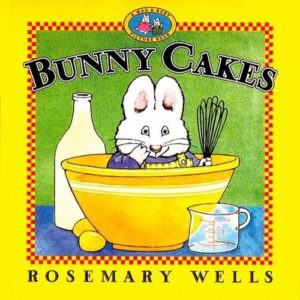
|
Rosemary Wells’s endearing Max and Ruby characters – featured in many books – are bunnies. In Bunny Cakes (Puffin, 2000) – one of my favorites – it’s time to bake a cake for Grandma’s birthday. Max is making an earthworm cake; big sister Ruby (“Don’t touch anything, Max”) is making an angel surprise cake with raspberry-fluff icing. Funny and priceless. For ages 3-6. |
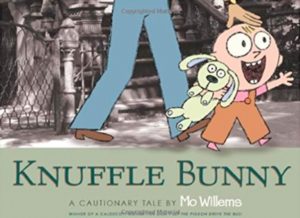
|
In Mo Willem’s Knuffle Bunny (Hyperion, 2004), Trixie – a toddler who is too young to talk – goes to the Laundromat with her father, taking along her stuffed bunny. The bunny is left behind, and Trixie, unable to explain what has happened, struggles, fusses, and finally melts down into an over-the-top tantrum. Her mother realizes what’s wrong and back to the Laundromat they go to retrieve the lost toy, upon which Trixie says her very first words: “Knuffle Bunny!” Illustrated in a mix of black-and-white photographs and bright cartoon drawings. For ages 3-6. |
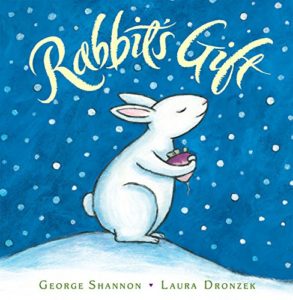
|
Rabbit’s Gift by George Shannon (Harcourt Children’s Books, 2007) is a lovely adaptation of a Chinese folktale. It’s cold and snowy, but Rabbit manages to find two turnips. Since one is plenty for him, he leaves the second for his friend Donkey. Donkey has found a potato, so he passes the turnip on to Goat – who has a cabbage, so he gives the turnip to Deer. On it goes until the turnip finally returns to Rabbit, who shares with all. The illustrations are great, including wonderful borders of stylized purple turnips. Included are Chinese ideograms for animal names. For ages 4-8. |
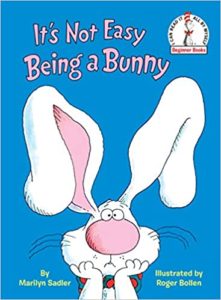
|
In Marilyn Sadler’s It’s Not Easy Being A Bunny (Random House Books for Young Readers, 1983), P.J. – unhappy with his large family, oversized ears, and diet of carrots – decides to be something else. Perhaps a bear – but hibernation is no fun. After many disappointing experiments, P.J. decides that bunnyhood is the best for him after all. For ages 4-8. |
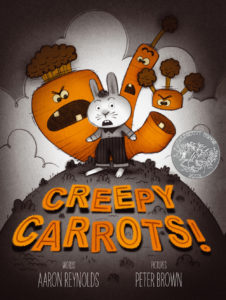
|
In Aaron Reynolds’s Creepy Carrots (Simon & Schuster, 2012), Jasper Rabbit is mad for carrots – especially the scrumptious carrots of Crackenhopper Field. Then greedy Jasper discovers that the carrots are following him. (Behind him: “the soft…sinister…tunktunktunk of carrots creeping.”) A hilarious just-creepy-enough horror story for ages 4-8. |
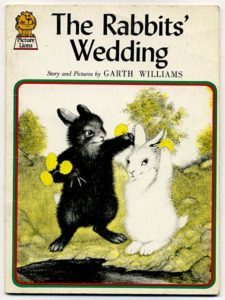
|
The Rabbits’ Wedding by Garth Williams (HarperCollins, 1958) – best-known for his illustrations of the Little House books – is a gentle story of a black rabbit and a white rabbit who want to be together “forever and ever.” Illustrations are almost entirely black and white, except for some glorious bright-yellow wedding dandelions. For ages 3-7. |
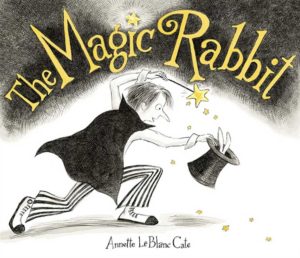
|
Annette Cate’s The Magic Rabbit (Candlewick, 2007) is the tale of a street magician and his beloved rabbit assistant who suddenly find themselves separated after a performance disaster. All looks bleak until a passion for popcorn (and a magical trail of gold stars) bring the two together again. For ages 4-8. |
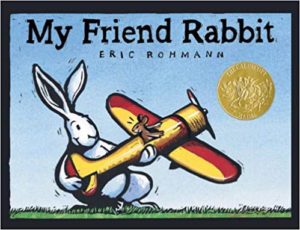
|
In Eric Rohmann’s My Friend Rabbit (Roaring Brook Press, 2011), Rabbit – as described by his friend Mouse – “means well. But whatever he does, wherever he goes, trouble follows.” Rabbit has pitched Mouse’s airplane into a tree, but – never at a loss (“Not to worry, Mouse. I’ve got an idea.”) – he organizes a pyramid of animals to reach the stuck plane. Just as all topple furiously to the ground, the plane is freed, and Mouse and Rabbit soar off, disturbingly off-course. To which Rabbit announces buoyantly: “Not to worry, Mouse. I’ve got an idea.” For ages 4-8. |
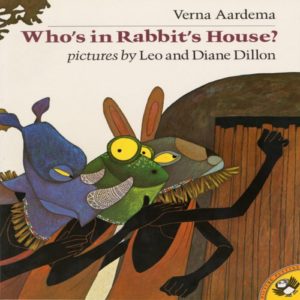
|
Verna Aardema’s Who’s in Rabbit’s House? (Puffin, 1992) is set in an African village where performers are donning fantastic animal masks in preparation for a play based on the folktale “Who’s in Rabbit’s House?” The story is told through the performance. Rabbit cannot get into her house because a horrible monster is inside, bellowing “I am the Long One. I eat trees and trample on elephants. Go away! Or I will trample on you!” The problem is finally solved by Frog, and the monster turns out to be a tiny caterpillar. For ages 5-9. |
| Susan Seale’s Make Me Musical! blog has a wonderful account of a children’s performance of “Who’s in Rabbit’s House?” with pictures of homemade animal masks. (Make some and try a performance of your own.) | |
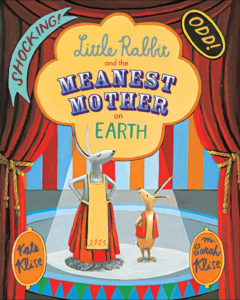
|
In Sarah Klise’s Little Rabbit and the Meanest Mother on Earth (Harcourt Children’s Books, 2010), Little Rabbit’s mother has told him that he can go to the circus – but only after he’s cleaned up his truly disastrous playroom. Instead, Little Rabbit sneaks off to the circus and offers the ringmaster a “Mysterious Marvel of Maternal Monstrosity” – the Meanest Mother on Earth, who has two heads, green teeth, and enjoys punishing the small and innocent. His mother turns the tables by showing the crowd the playroom (an “Emporium of Odiferous Oddities”). For ages 5-9. |
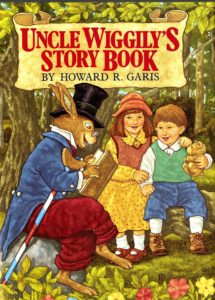
|
The collected stories in Robert Garis’s Uncle Wiggily’s Story Book (Grosset & Dunlap, 1987) were first published in 1921. All feature the kindly bunny gentleman, Uncle Wiggily Longears, who wears a top hat, carries a striped cane, and devotes himself to solving children’s problems. Problems, circa 1921, were things like toothaches and freckles. For ages 5-10. |
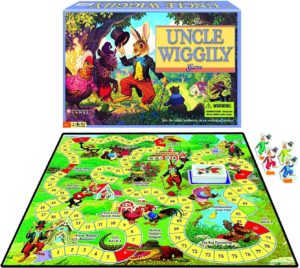
|
In the Uncle Wiggily Game, players race their rabbits along a winding path from Uncle Wiggily’s Hollow Stump Bungalow to Dr. Possum’s office. For 2-4 players, ages 4 and up. |
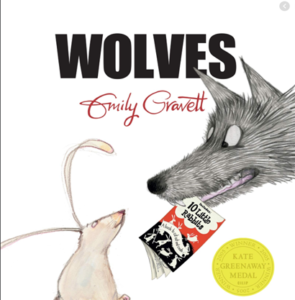
|
What eats rabbits? In Emily Gravett’s Wolves (Simon & Schuster, 2006), Rabbit has borrowed a book on wolves from the library and is so absorbed in it that he fails to notice the real-live wolf following him home. Readers learn about wolves along with the reading Rabbit, but they also – unlike the oblivious Rabbit – can see the stalking wolf. The final pages show a tattered book and no rabbit, but the author neatly provides reassurance. For ages 6-9. |
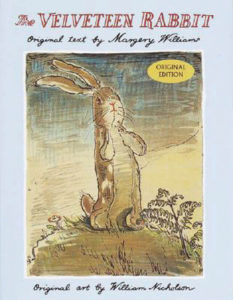
|
Margery Williams’s The Velveteen Rabbit, first published in 1922, is now available in many editions, though my favorite remains the original with illustrations by William Nicholson (Doubleday, 1958). This is a lovely short chapter book about how beloved toys become real. It begins when the Boy gets the Rabbit as a Christmas gift – “fat and bunchy, as a rabbit should be; his coat was spotted brown and white, he had real thread whiskers, and his ears were lined with pink sateen.” For all ages. |
| See The Velveteen Rabbit online with the original text and illustrations. | |
| The Rabbit Ears Library audio version of The Velveteen Rabbit is beautifully narrated by Meryl Streep. Other rabbit tales from Rabbit Ears include Brer Rabbit and the Tar Baby and The Tale of Peter Rabbit. | |
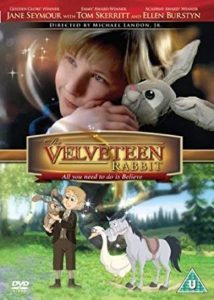
|
A 2009 movie version of The Velveteen Rabbit, directed by Michael Landon, combines live-action and cartoon animation in a story that has at best a vague connection to the book. (First hint is the summary which reads “A lonely boy wins over his distant father and strict grandmother with help from a brave velveteen rabbit whose one wish is to become a real rabbit someday.”) |
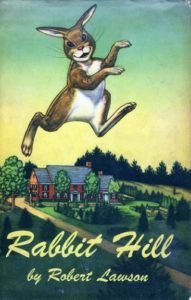 |
Robert Lawson’s Newbery-winning Rabbit Hill (Puffin, 2007), originally published in 1944, is the story of what happens when new people move into the long-empty Big House and how they react with the animal residents (many of them rabbits) of Rabbit Hill. A gentle 128-page classic for ages 6-11. |
| Design a Rabbit Hill Garden has instructions and a lesson plan. | |
| Also see Gardening. | |
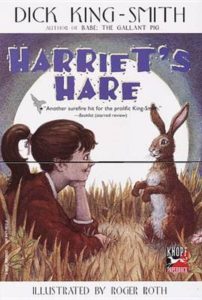 |
In a wheat field on her father’s farm, lonely eight-year-old Harriet of Dick King-Smith’s Harriet’s Hare (Yearling, 1997) meets Wiz – a talking hare who is actually a shape-shifting alien from the planet Pars. Unfortunately her new friend has to return home when the full moon rises. For ages 6-10. |
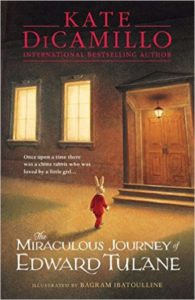
|
The hero of Kate DiCamillo’s The Miraculous Journey of Edward Tulane (Candlewick, 2009) is a self-satisfied china rabbit, possessor of a huge wardrobe of silk suits, owned and adored by a little girl named Abilene. Then Abilene and her parents embark on a sea voyage and disaster strikes: Edward is hurled overboard. So begins his journey. He is dredged up from the ocean and brought home by a fisherman, and then passes on to a succession of caretakers, who – collectively – help him come to understand love, loss, and hope. For ages 7-12. |
| Put on a play based on the book! | |
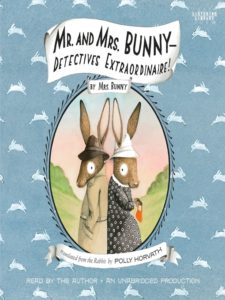
|
In Polly Horvath’s hilarious Mr. and Mrs. Bunny – Detectives Extraordinaire (Yearling, 2014), Madeline’s parents – who play the marimba and make jewelry out of sand dollars, have been kidnapped by foxes. Madeline sets out to find them – and ends up hiring Mr. and Mrs. Bunny. A fun read for ages 8-12.
Also see the sequel: Lord and Lady Bunny – Almost Royalty (2016). |
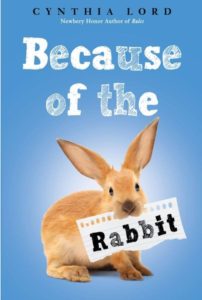 |
In Cynthia Lord’s Because of the Rabbit (Scholastic, 2019), homeschooled Emma is starting school for the first time; there she and an unpopular boy named Jack forge a bond over a rescue rabbit. It’s a lovely story of friendship, honesty, and accepting differences. For ages 8-12. |
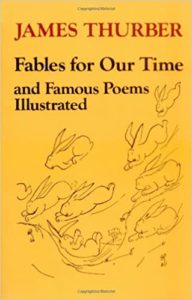 |
James Thurber’s Fables for Our Time (HarperPerennial, 1983) includes the story of “The Rabbits Who Caused All the Trouble,” a sobering (though darkly funny) fable, the moral of which is “Run, don’t walk, to the nearest desert island.” |
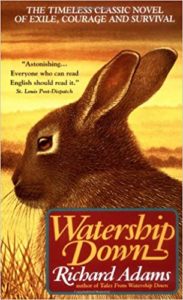
|
Richard Adams’s rabbit world of Watership Down (Scribner, 2005) is now a staple of high-school reading lists – and deservedly. The plot centers around a small band of rabbits – Hazel, Fiver, Bigwig, Bluebell, and Dandelion – who leave their home warren after a warning from the clairvoyant Fiver that destruction (land developers) is imminent, looking for a new and safer home. Adams creates a complex and believable culture of rabbits, with social structure, language, customs, and religion. |
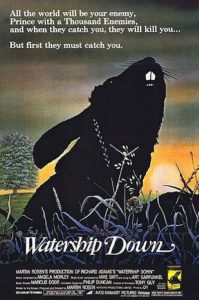 |
An excellent animated version of Watership Down was released in 1978. Despite the cartoon format, it is not recommended for young children – this is a serious drama and there are some frightening and bloody scenes. |
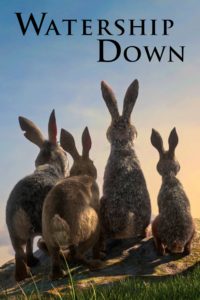 |
A TV mini-series of Watership Down (2018) is rated PG. |
